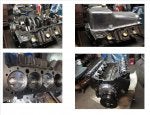The SB400 was first used in 70 model full size cars and trucks and Monte Carlos.
Chevelles/Malibus/El Caminos got the 400 in 73.
The LAST year for the 400 was 1976 for cars and Monte Carlo.
Trucks continued to use the SB400 to its end in 1980.
Properly built and with a good cooling system, SB400s do NOT, repeat, NOT typically over heat.
The SB400 was used in trucks from 70 to 80 --------------- but it is NOT specifically a truck engine. That's like the old myth of the 348 originally being intended as a truck engine-------------NOT SO!
Oh ya, and MANY, MANY, MANY, MANY of the vehicles that were built with a SB400 also had air cond.
The 70-74 SB400s were 2bl carb engines. A 4bl (Q-jet) SB400 became available in 75.
ALL 70-72 SB400 blocks were 4bolt main ONLY. The 73-80 SB400 blocks were 2bolt ONLY.
Everyone has always believed that a 4bolt block was more desirable. BUT, time and experience has shown that the SB400 2bolt block was actually stronger---------------especially if studs were used instead of bolts for the main caps. The reasoning for a 2bolt 400 block being stronger is because the hole spacing for the main cap bolts is wider and the outer bolt holes go into a thinner/weaker part of the main webbing. And when the webbing is drilled/tapped for the outer bolts, it weakens the webbing. That's what all the SB400 gurus have projected. WELL, Tom Parsons has NEVER seen a 4bolt SB400 come apart in the main webbing. Sometimes I turn the 4bolt SB400 in my 56 Vette 6600rpm--------------been in that car for 20yrs. And here, I might add, all the 400 gurus recommend keeping the rpms below 6000 on a SB400 (I kind of have to agree with that philosophy, but I don't always adhere to that).
So, my bottom line opinion is, do not be so quick to avoid, or criticize, a SB400. It is a natural as a drop-in, bolt-in, hi-perf (or granny grocery getter) engine for replacing an original 265-283-327-350 small block.
Now, here is my only caution. When building a very healthy SB400, it is possible------------REAL QUICK-----------to get into the price range of what a nice BB, such as a 454, can cost. Shop around for parts and machine work, do as much of the misc engine work yourself, and make sure just what you really expect to achieve regarding torque/power.












